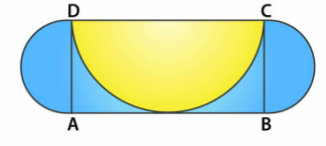In Fig. 32, ABCD is a rectangle of length AB=40 cm and breadth BC=25 cm. If P,Q,R,S be the mid-points of the sides AB, BC, CD and DA respectively, find the area of the shaded region.
To find the area of the shaded region in rectangle ABCD with midpoints P, Q, R, and S, we can follow these steps:
Step 1: Calculate the area of rectangle ABCD
The area of a rectangle is given by the formula:
Area=Length×Breadth
Here, the length AB=40cm and the breadth BC=25cm.
So, the area of rectangle ABCD is:
AreaABCD=40cm×25cm=1000cm2
Step 2: Identify the dimensions of triangles formed
Since P, Q, R, and S are midpoints, we can determine the dimensions of the triangles formed:
- The length of each segment from the midpoints can be calculated as follows:
- AP=PB=AB2=402=20cm
- BQ=QC=BC2=252=12.5cm
Step 3: Calculate the area of one triangle
The area of a triangle is given by the formula:
Area=12×Base×Height
For triangle DSR:
- Base DS=12.5cm
- Height DR=20cm
Thus, the area of triangle DSR is:
AreaDSR=12×12.5cm×20cm=12×250=125cm2
Step 4: Calculate the total area of all four triangles
Since all four triangles (DSR, RQ, PQ, and SP) have the same dimensions, the total area of the triangles is:
AreaTotal Triangles=4×AreaDSR=4×125cm2=500cm2
Step 5: Calculate the area of the shaded region
The area of the shaded region is the area of rectangle ABCD minus the total area of the triangles:
AreaShaded=AreaABCD−AreaTotal Triangles=1000cm2−500cm2=500cm2
Final Answer
The area of the shaded region is:
AreaShaded=500cm2
---
The area of a rectangle is given by the formula:
Area=Length×Breadth
Here, the length AB=40cm and the breadth BC=25cm.
AreaABCD=40cm×25cm=1000cm2
Since P, Q, R, and S are midpoints, we can determine the dimensions of the triangles formed:
- The length of each segment from the midpoints can be calculated as follows:
- AP=PB=AB2=402=20cm
- BQ=QC=BC2=252=12.5cm
The area of a triangle is given by the formula:
Area=12×Base×Height
For triangle DSR:
- Base DS=12.5cm
- Height DR=20cm
AreaDSR=12×12.5cm×20cm=12×250=125cm2
Since all four triangles (DSR, RQ, PQ, and SP) have the same dimensions, the total area of the triangles is:
AreaTotal Triangles=4×AreaDSR=4×125cm2=500cm2
The area of the shaded region is the area of rectangle ABCD minus the total area of the triangles:
AreaShaded=AreaABCD−AreaTotal Triangles=1000cm2−500cm2=500cm2
The area of the shaded region is:
AreaShaded=500cm2
Topper's Solved these Questions
Similar Questions
ABCD is a rhombus and P, Q, R, S are the mid-points of AB, BC, CD, DA respectively. Prove that PQRS is a rectangle.
View SolutionIn Figure, ABCD is a rectangle with sides AB=10cm and AD=5cm. Find the area of EFG
View SolutionIn Figure, ABCD is a rectangle with sides AB=10cm and AD=5cm. Find the area of EFG
View SolutionABCD is a rectangle formed by joining the points A(−1, −1), B(−1, 4), C(5, 4) and D(5, −1). P, Q, R and S are the mid-points of sides AB, BC, CD and DA respectively. Is the quadrilateral PQRS a square? a rectangle? or a rhombus? Justify your answer.
View SolutionD, E, F are the mid-points of the sides BC, CA and AB respectively of a ΔABC . Determine the ratio of the areas of DEF and ABC .
View SolutionIn ABC, D and E are the mid-points of AB and AC respectively. Find the ratio of the areas of ADE and ABC .
View SolutionLet ABCD be a parallelogram of area 124cm2. If E and F are the mid-points of sides AB and CD respectively, then find the area of parallelogram AEFD.
View SolutionABCD is a rhombus and P,Q,R,S are the mid-points of AB,BC,CD,DA respectively. Prove that PQRS is a rectangle.
View SolutionIf ABCD is a rectangle with ∠BAC=320, find the measure of ∠DBC
View SolutionIn Fig. 15.93, ABCD is a rectangle with AB=14 cm and BC=7 cm . Taking DC, BC and AD as diameters, three semi-circles are drawn as shown in the figure. Find the area of the shaded region.

View Solution
